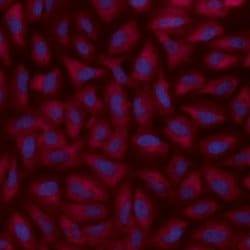Learn More
Invitrogen™ alpha Adaptin Monoclonal Antibody (AP6), Alexa Fluor™ 647
Mouse Monoclonal Antibody
Supplier: Invitrogen™ MA1064A647
Description
MA1-064A647 detects assembly polypeptide 2 (AP2) from a wide variety of mammalian sources, including human, hamster, monkey, bovine, rat, and mouse. It recognizes the products of both alpha-adaptin genes, alpha A and alpha C as well as an alternatively spliced isoform of alpha adaptin found in neurons.
Component of the adaptor protein complex 2 (AP-2). Adaptor protein complexes function in protein transport via transport vesicles in different membrane traffic pathways. Adaptor protein complexes are vesicle coat components and appear to be involved in cargo selection and vesicle formation. AP-2 is involved in clathrin-dependent endocytosis in which cargo proteins are incorporated into vesicles surrounded by clathrin (clathrin-coated vesicles, CCVs) which are destined for fusion with the early endosome. The clathrin lattice serves as a mechanical scaffold but is itself unable to bind directly to membrane components. Clathrin-associated adaptor protein (AP) complexes which can bind directly to both the clathrin lattice and to the lipid and protein components of membranes are considered to be the major clathrin adaptors contributing the CCV formation. AP-2 also serves as a cargo receptor to selectively sort the membrane proteins involved in receptor-mediated endocytosis. AP-2 seems to play a role in the recycling of synaptic vesicle membranes from the presynaptic surface. AP-2 recognizes Y-X-X-[FILMV] (Y-X-X-Phi) and [ED]-X-X-X-L-[LI] endocytosis signal motifs within the cytosolic tails of transmembrane cargo molecules. AP-2 may also play a role in maintaining normal post-endocytic trafficking through the ARF6-regulated, non-clathrin pathway. The AP-2 alpha subunit binds polyphosphoinositide-containing lipids, positioning AP-2 on the membrane. The AP-2 alpha subunit acts via its C-terminal appendage domain as a scaffolding platform for endocytic accessory proteins. The AP-2 alpha and AP-2 sigma subunits are thought to contribute to the recognition of the [ED]-X-X-X-L-[LI] motif.
Specifications
| alpha Adaptin | |
| Monoclonal | |
| 1.0 mg/mL | |
| PBS with 1.0mg/mL BSA and 0.05% sodium azide | |
| O95782, P17426 | |
| Ap2a1 | |
| Purified adaptors. | |
| 50 μg | |
| Primary | |
| Human, Mouse, Rat, Monkey, Bovine, Hamster | |
| Antibody | |
| IgG1 |
| Immunocytochemistry, Immunofluorescence | |
| AP6 | |
| Alexa Fluor 647 | |
| Ap2a1 | |
| 100 kDa coated vesicle protein A; adapter-related protein complex 2 alpha-1 subunit; adapter-related protein complex 2 subunit alpha-1; adaptin, alpha A; adaptor protein complex AP-2 subunit alpha-1; adaptor protein complex AP-2, alpha 1 subunit; adaptor related protein complex 2 alpha 1 subunit; adaptor related protein complex 2 subunit alpha 1; adaptor related protein complex 2, alpha 1 subunit; adaptor-related protein complex 2 subunit alpha-1; adaptor-related protein complex 2, alpha 1 subunit; adaptor-related protein complex 2, short form; adaptor-related protein complex AP-2, alpha 1 subunit; Adtaa; ADTAB; alpha1-adaptin; alpha2-adaptin; Alpha-adaptin A; alpha-adaptin C; AP2; AP-2 complex subunit alpha-1; Ap2a1; AP2-ALPHA; CLAPA1; CLAPA2; Clathrin assembly protein complex 2 alpha-A large chain; clathrin-associated/assembly/adaptor protein, large, alpha 1; HIP9; HIP-9; HYPJ; plasma membrane adaptor HA2/AP2 adaptin alpha A subunit | |
| Mouse | |
| Protein G | |
| RUO | |
| 100772481, 11771, 160, 308578, 784636 | |
| 4°C, store in dark, DO NOT FREEZE! | |
| Liquid |
Safety and Handling
Your input is important to us. Please complete this form to provide feedback related to the content on this product.

